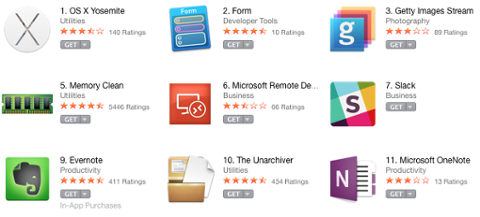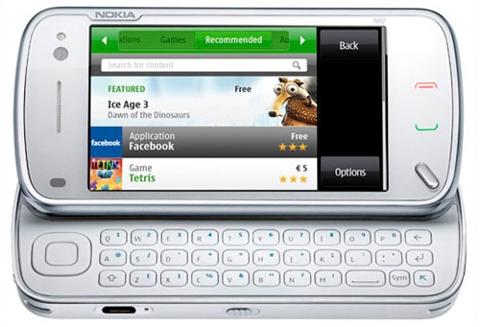The Mac App Store is a relic. Dated, bloated and just downright stodgy, it’s evidence that Apple
really needs to stomp on the gas pedal when it comes to macOS development. As a sort of A/B test, the crew at ia.net
analyzed what happened when they ran the Mac App Store through a variety of ‘funneling’ techniques. The crew's typical customer-engagement funnel is likely the same as many developers' paths: Twitter, then their site, then onto the Mac App Store. But in their estimation, this “long, shaky funnel” that doesn’t provide “useful” data from Apple’s own analytics suite. One of the main takeaways is that ia.net was being punished for being popular. The firm is dedicated to blogging, which inherently leads to more traffic for both the site and the Mac App Store. But as traffic to Apple’s app portal spiked, ranking for the company’s app,
iA Writer, dropped.

An easy assumption would be that traffic without sales seemed dubious to Apple's algorithm... but sales coincided with traffic (that is to say, sales were also ‘up’). Traffic direct from Twitter to the Mac App Store brought no meaningful bump in sales, but iA Writer’s ranking was punished severely nonetheless. If iA Writer were dependent on the Mac App Store, this would be a critical issue. The team discovered that a diminished ranking had no effect on overall income. It
did affect sales through the Mac App Store, though not total revenue (the firm offers a trial of iA Writer via its site). Price changes up or down also had no effect on revenue, though the firm isn't sure why that is. One thing is clear for iA: Apple’s Mac App Store is the weak link in its chain. The Apple algorithm meant to thwart ‘gaming’ the App Store’s rankings is errantly punishing iA Writer, which tells us Apple has attempted to algorithmically solve the problem of a bloated app portal stuffed with tons of zombie and/or just plain bad apps.

This algorithmic effort means Apple
wants the Mac App Store to be a reliable, user-friendly destination. Unfortunately, it’s not, and Apple hasn’t done the heavy lifting to make it one.
There’s chatter that Apple will soon merge the iOS and macOS app stores into one cohesive unit, which may help on this front. The iOS App Store is actually interesting, contextual and lively. Apple’s Mac App Store is a platform that snipes 30 percent of an app’s revenue for the pleasure of hosting and processing payments. This was fair in a time when doing it yourself was difficult, which isn’t the case in 2018. iA doesn’t advocate leaving Apple's desktop app portal, but admits that spam algorithm is problematic. Probably a much stronger focus for Apple should be that, regardless of what the Mac App Store did algorithmically, iA Writer’s revenue remained unchanged
because it didn’t rely on Apple. This isn’t the first time we’ve heard the Mac App Store is itself a zombie.
Rogue Amoeba’s own analytics showed its sales were steady whether it sold through the MAS or not.
Independent research shows developers have an increasingly dour view of the Mac App Store. But spinning up your own hosting server and point-of-sale service isn’t the silver bullet. Even iA reminds us that ignoring the Mac App Store alienates customers who still use it for discovery. Looking at the data provided, we’d have to conclude that Apple knows the Mac App Store is little more than a playground for bad apps, which it then tries to punish with an algorithm because it doesn’t trust how traffic is generated. We can’t conclude why else a traffic spike would immediately result in an app’s ranking being diminished – especially when sales are relatively even. WWDC 2018 will hopefully be the year Apple prioritizes macOS developers. Hopefully, that starts with a revamped Mac App Store, with algorithms and tools to make it a destination for users again.
 An easy assumption would be that traffic without sales seemed dubious to Apple's algorithm... but sales coincided with traffic (that is to say, sales were also ‘up’). Traffic direct from Twitter to the Mac App Store brought no meaningful bump in sales, but iA Writer’s ranking was punished severely nonetheless. If iA Writer were dependent on the Mac App Store, this would be a critical issue. The team discovered that a diminished ranking had no effect on overall income. It did affect sales through the Mac App Store, though not total revenue (the firm offers a trial of iA Writer via its site). Price changes up or down also had no effect on revenue, though the firm isn't sure why that is. One thing is clear for iA: Apple’s Mac App Store is the weak link in its chain. The Apple algorithm meant to thwart ‘gaming’ the App Store’s rankings is errantly punishing iA Writer, which tells us Apple has attempted to algorithmically solve the problem of a bloated app portal stuffed with tons of zombie and/or just plain bad apps.
An easy assumption would be that traffic without sales seemed dubious to Apple's algorithm... but sales coincided with traffic (that is to say, sales were also ‘up’). Traffic direct from Twitter to the Mac App Store brought no meaningful bump in sales, but iA Writer’s ranking was punished severely nonetheless. If iA Writer were dependent on the Mac App Store, this would be a critical issue. The team discovered that a diminished ranking had no effect on overall income. It did affect sales through the Mac App Store, though not total revenue (the firm offers a trial of iA Writer via its site). Price changes up or down also had no effect on revenue, though the firm isn't sure why that is. One thing is clear for iA: Apple’s Mac App Store is the weak link in its chain. The Apple algorithm meant to thwart ‘gaming’ the App Store’s rankings is errantly punishing iA Writer, which tells us Apple has attempted to algorithmically solve the problem of a bloated app portal stuffed with tons of zombie and/or just plain bad apps.  This algorithmic effort means Apple wants the Mac App Store to be a reliable, user-friendly destination. Unfortunately, it’s not, and Apple hasn’t done the heavy lifting to make it one. There’s chatter that Apple will soon merge the iOS and macOS app stores into one cohesive unit, which may help on this front. The iOS App Store is actually interesting, contextual and lively. Apple’s Mac App Store is a platform that snipes 30 percent of an app’s revenue for the pleasure of hosting and processing payments. This was fair in a time when doing it yourself was difficult, which isn’t the case in 2018. iA doesn’t advocate leaving Apple's desktop app portal, but admits that spam algorithm is problematic. Probably a much stronger focus for Apple should be that, regardless of what the Mac App Store did algorithmically, iA Writer’s revenue remained unchanged because it didn’t rely on Apple. This isn’t the first time we’ve heard the Mac App Store is itself a zombie. Rogue Amoeba’s own analytics showed its sales were steady whether it sold through the MAS or not. Independent research shows developers have an increasingly dour view of the Mac App Store. But spinning up your own hosting server and point-of-sale service isn’t the silver bullet. Even iA reminds us that ignoring the Mac App Store alienates customers who still use it for discovery. Looking at the data provided, we’d have to conclude that Apple knows the Mac App Store is little more than a playground for bad apps, which it then tries to punish with an algorithm because it doesn’t trust how traffic is generated. We can’t conclude why else a traffic spike would immediately result in an app’s ranking being diminished – especially when sales are relatively even. WWDC 2018 will hopefully be the year Apple prioritizes macOS developers. Hopefully, that starts with a revamped Mac App Store, with algorithms and tools to make it a destination for users again.
This algorithmic effort means Apple wants the Mac App Store to be a reliable, user-friendly destination. Unfortunately, it’s not, and Apple hasn’t done the heavy lifting to make it one. There’s chatter that Apple will soon merge the iOS and macOS app stores into one cohesive unit, which may help on this front. The iOS App Store is actually interesting, contextual and lively. Apple’s Mac App Store is a platform that snipes 30 percent of an app’s revenue for the pleasure of hosting and processing payments. This was fair in a time when doing it yourself was difficult, which isn’t the case in 2018. iA doesn’t advocate leaving Apple's desktop app portal, but admits that spam algorithm is problematic. Probably a much stronger focus for Apple should be that, regardless of what the Mac App Store did algorithmically, iA Writer’s revenue remained unchanged because it didn’t rely on Apple. This isn’t the first time we’ve heard the Mac App Store is itself a zombie. Rogue Amoeba’s own analytics showed its sales were steady whether it sold through the MAS or not. Independent research shows developers have an increasingly dour view of the Mac App Store. But spinning up your own hosting server and point-of-sale service isn’t the silver bullet. Even iA reminds us that ignoring the Mac App Store alienates customers who still use it for discovery. Looking at the data provided, we’d have to conclude that Apple knows the Mac App Store is little more than a playground for bad apps, which it then tries to punish with an algorithm because it doesn’t trust how traffic is generated. We can’t conclude why else a traffic spike would immediately result in an app’s ranking being diminished – especially when sales are relatively even. WWDC 2018 will hopefully be the year Apple prioritizes macOS developers. Hopefully, that starts with a revamped Mac App Store, with algorithms and tools to make it a destination for users again. 


